AMD's Radeon HD 6970 & Radeon HD 6950: Paving The Future For AMD
by Ryan Smith on December 15, 2010 12:01 AM ESTMeet the 6970 & 6950
Now that we’ve finally looked at what makes the 6900 series tick, let’s look at the cards themselves.
If you’re familiar with the 6800 series, then the 6900 series is nearly identical. For our reference cards AMD is using the same style they used for the 6800 cards, utilizing a completely shrouded and squared off design. Furthermore unlike the 5800 series AMD is utilizing the same cooler/PCB/layout for both the 6970 and 6950, meaning virtually everything we have to say about one card applies to the other as well. In this case we’ll be using the 6970 as our point of reference.
Starting with the length, the 6970 measures a hair over 10.5”, giving it the same length as the 5870. Buyers looking for a 5850-like shorter card will have to look elsewhere else for the moment, as the 6950 is the same 10.5”. Power is provided by a set of 6+8pin PCIe power sockets at the top of the card, necessary as the 6970’s 250W TDP is in excess of the 225W 6+6 limit. The 6950 on the other hand does use 6+6 PCIe power sockets in the same location, afforded by its lower 200W TDP.
Cracking open the 6970 we find the PCB with the Cayman GPU at the center in all its 389mm2 glory. Around it are 8 2Gb Hynix GDDR5 chips, rated for 6Gbps, 0.5Gbps higher than what the card actually runs at. As we’ve said before the hardest part about using GDDR5 at high speeds is the complexity of building a good memory bus, and this continues to be the case here. AMD has made progress on getting GDDR5 speeds up to 5.5Gbps primarily through better PCB designs, but it looks like hitting 6Gbps and beyond is going to be impractical, at least for a 256bit bus design. Ultimately GDDR5 was supposed to top out at 7Gbps, but with the troubles both AMD and NVIDIA have had, we don’t expect anyone will ever reach it.
Moving on to the cooling apparatus, vapor chamber coolers are clearly in vogue this year. AMD already used a vapor chamber last year on the dual-GPU 5970, while this year both AMD and NVIDIA are using them on their high-end single-GPU products. Compared to a more traditional heatpipe cooler, a vapor chamber cooler is both more efficient than a heatpipe cooler and easier to build in to a design as there’s no need to worry about where to route the heatpipes. Meanwhile airflow is provided by a blower at the rear of the card; compared to the 5870 the blower on the 6970 is just a bit bigger, a fair consideration given that the 6970 is a hotter card. Interestingly in spite of the higher TDP AMD has still been able to hold on to the half-height exhaust port at the front of the card.
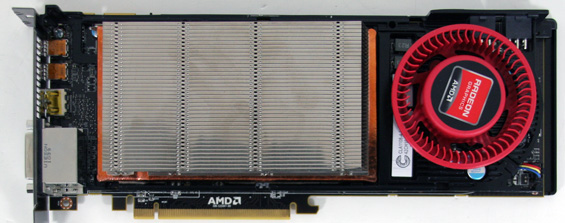
As for I/O we’re looking at AMD’s new port layout as seen on the 6800 series: 2x DVI, 1x HDMI 1.4, and 2x mini-DP. All together the 6970 can drive up to 6 monitors through the use of the mini-DP ports and a MST hub. Compared to the 5800 series the DVI-type ports have a few more restrictions however; along with the usual limitation of only being able to drive 2 DVI-type monitors at once, AMD has reduced the 2nd DVI port to a single-link port (although it maintains the dual-link pin configuration), so you won’t be able to drive 2 2560 or 3D monitors using DVI ports.
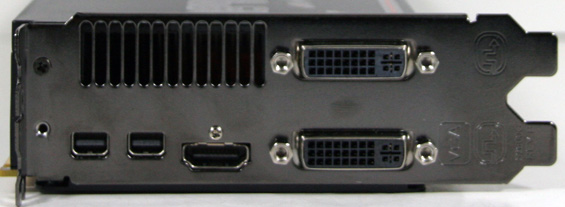
Elsewhere the card features 2 CrossFire connectors at the top, allowing for tri-CF for the particularly rich and crazy. Next to the CF connectors you’ll find AMD’s not-so-secret switch, which controls the cards’ switchable BIOSes. The card has 2 BIOSes, which can be changed with the flick of a switch. The primary purpose of this switch is to offer a backup BIOS in case of a failed BIOS flash, as it’s possible to boot the card with the secondary BIOS and then switch back to the primary BIOS after the computer has started in order to reflash it. Normally AMD doesn’t strike us as very supportive of BIOS flashing, so this is an interesting change.
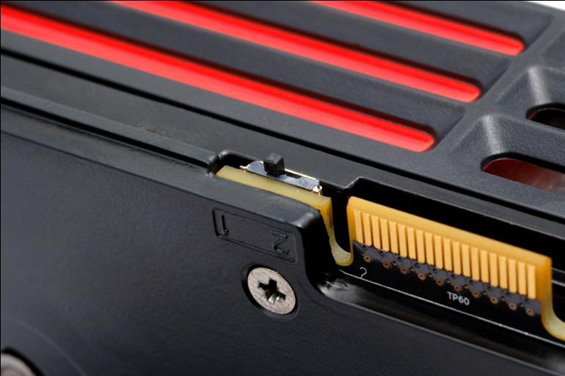
The BIOS Switch
Like the 5870 the back side is covered with a metal plate, and while there aren’t any components on the back side of the card to protect, this is a nice touch by making it easier to grab the card without needing to worry about coming in contact with a pointy contact.
Finally, while the card’s overall dimensions are practically identical to the 5870, we noticed that the boxy design isn’t doing AMD any favors when it comes to CrossFire mode with 2 cards right next to each other. The 5870’s shroud actually jutted out just a bit at the center, keeping the ventilation hole for the blower from pressing right up against the back of another card. The 6970 does not have this luxury, meaning it’s possible to practically seal the upper card depending on how you screw the cards down. As a result our CF temperatures run high, but not to a troublesome degree. We’d still encourage AMD to take a page from NVIDIA’s book and to bring the shroud in a bit around the blower so that it has more room to breathe, particularly as their TDP is approaching NVIDIA’s. In the meantime we’d definitely suggest spacing your cards apart if you have a motherboard and case that allows it.


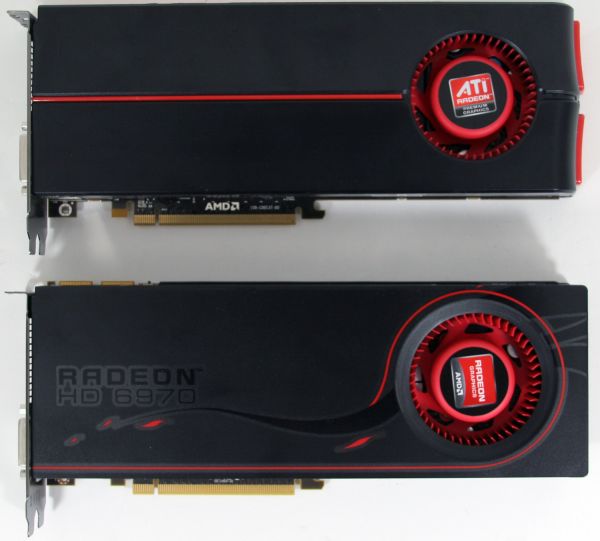

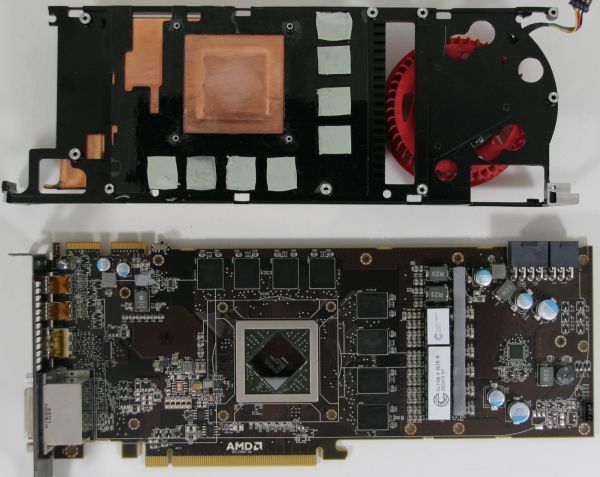








168 Comments
View All Comments
AnnihilatorX - Thursday, December 16, 2010 - link
I disagree with you rarsonThis is what sets Anandtech apart, it has quality over quantity.
Anandtech is the ONLY review site which offers me comprehensive information on the architecture, with helpful notes on the expected future gaming performance. It mention AMD intended the 69xx to run on 35nm, and made sacrifices. If you go to Guru3D''s review, the editor in the conclusion stated that he doesn't know why the performance lacks the wow factor. Anandtech answered that question with the process node.
If you want to read reviews only, go onto google and search for 6850 review, or go to DailyTech's daily recent hardware review post, you can find over 15 plain reviews. Even easier, just use the Quick Navigation menu or the Table of Content in the freaking first page of article. This laziness does not entrice sypathy.
Quidam67 - Thursday, December 16, 2010 - link
Rarson's comments may have been a little condescending in their tone, but I think the critism was actually constructive in nature.You can argue the toss about whether the architecture should be in a separate article or not, but personally speaking, I actually would prefer it was broken out. I mean, for those who are interested, simply provide a hyper-link, that way everyone gets what they want.
In my view, a review is a review and an analysis on architecture can compliment that review but should not actually a part of the review itself. A number of other sites follow this formula, and provide both, but don't merge them together as one super-article, and there are other benefits to this if you read on.
The issue of spelling anf grammer is trivial, but in fact could be symptomatic of a more serious problem, such as the sheer volume of work Ryan has to perform in the time-frame provided, and the level of QA being squeesed in with it. Given the nature of NDA's, perhaps it might take the pressure off if the review did come first, and the architecture second, so the time-pressures weren't quite so restrictive.
Lastly, employing a professional proof-reader is hardly an insult to the original author. It's no different than being a software engineer (which I am) and being backed up by a team of quality test analysts. It certainly makes you sleep better when stuff goes into production. Why should Ryan shoulder all the responsibility?
silverblue - Thursday, December 16, 2010 - link
I do hope you're joking. :) (can't tell at this early time)Arnulf - Thursday, December 16, 2010 - link
"... unlike Turbo which is a positive feedback mechanism."Turbo is a negative feedback mechanism. If it was a positive feedback mechanism (= a consequence of an action resulting in further action in same direction) the CPU would probably burn up almost instantly after Turbo triggered as its clock would increase indefinitely, ever more following each increase, the higher the temperature, the higher the frequency. This is not how Turbo works.
Negative feedback mechanism is a result of an action resulting in reaction (= action in the opposite direction). In the case of CPUs and Turbo it's this to temperature reaction that keeps CPU frequency under control. The higher the temperature, the lower the frequency. This is how Turbo and PowerTune work.
The fact that Turbo starts at lower frequency and ramps it up and that PowerTune starts at higher frequency and brings it down has no bearing on whether the mechanism of control is called "positive" or "negative" feedback.
Considering your fondness for Wikipedia (as displayed by the reference in the article) you might want to check out these:
http://en.wikipedia.org/wiki/Negative_feedback
http://en.wikipedia.org/wiki/Positive_feedback
and more specifically:
http://en.wikipedia.org/wiki/Negative_feedback#Con...
Ryan Smith - Thursday, December 16, 2010 - link
Hi Arnulf;Fundamentally you're right, so I won't knock you. I guess you could say I'm going for a very loose interpretation there. The point I'm trying to get across is that Turbo provides a performance floor, while PowerTune is a performance ceiling. People like getting extra performance for "free" more than they like "losing" performance. Hence one experience is positive and one is negative.
I think in retrospect I should have used positive/negative reinforcement instead of feedback.
Soda - Thursday, December 16, 2010 - link
Anyone noticed that the edge missing og the boards 8-pin power connector ?Apparently the AMD made a mistake in the reference design of the board and didn't calculating the space needed by the cooler.
If you look closely on the power connector in http://images.anandtech.com/doci/4061/6970Open.jpg you'll notice the missing edge.
For a full story on the matter you can go to http://www.hardwareonline.dk/nyheder.aspx?nid=1060...
For the english speaking people I suggest the googlish version here http://translate.google.com/translate?hl=da&sl...
There are some pictures to backup the claim the mistake made AMD here.
Though it haven't been confirmed by AMD if this is only a mistake on the review boards or all cards of the 69xx series.
versesuvius - Thursday, December 16, 2010 - link
I have a 3870, on a 17 inch monitor, and everything is fine as long as games go. The hard disk gets in the way sometimes, but that is just about it. All the games run fine. No problem at all. Oh, there's more: They run better on the lousy XBOX. Why the new GPU then? Giant monitors? Three of them? Six of them? (The most fun I had on Anandtech was looking at pictures of AT people trying to stabilize them on a wall). Oh, the "Compute GPU"? Wouldn't that fit on a small PCI card, and act like the old 486 coprecessor, for those who have some use for it? Or is it just a silly excuse for not doing much at all, or rather not giving much to the customers, and still charge the same? The "High End"! In an ideal world the prices of things go down, and more and more people can afford them. That lovely capitalist idea was turned on its head, sometime in the eighties of the last century, and instead the notion of value was reinvented. You get more value, for the same price. You still have to pay $400 for your graphic card, even though you do not need the "Compute GPU", and you do not need the aliased superduper antialiasing that nobody yet knows how to achieve in software. Can we have a cheap 4870? No that is discontinued. The 58 series? Discontinued. There are hundreds of thousands or to be sure, millions of people who will pay 50 dollars for one. All ATI or Nvidia need to do is to fine tune the drivers and reduce power consumption. Then again, that must be another "High End" story. In fact the only tale that is being told and retold is "High End"s and "Fool"s, (i.e. "We can do whatever we want with the money that you don't have".) Until better, saner times. For now, long live the console. I am going to buy one, instead of this stupid monstrosity and its equally stupid competitive monstrosity. Cheaper, and gets the job done in more than one way.End of Rant.
God Bless.
Necc - Thursday, December 16, 2010 - link
So True.Ananke - Thursday, December 16, 2010 - link
Agree. I have 5850 and it does work fine, and I got it on day one at huge discount, but still - it is kind of worthless. Our entertainment comes more exclusively from consoles, and I discrete high end card that commands above $100 price tag is worthless. It is nice touch, but I have no application for it in everyday life, and several months later is already outdated or discontinued.My guess, integrated in the CPU graphics will take over, and the mass market discrete cards will have the fate of the dinosaurs very soon.
Quidam67 - Thursday, December 16, 2010 - link
Wonderfully subversive commentary. Loved it.Still, the thing I like about the High end (I'll never buy it until my Mortgage is done with) is that it filters down to the middle/low end.
Yes, lots of discontinued product lines but for example, I thought the HD5770 was a fantastic product. Gave ample performance for maintstream gamers in a small form-factor (you can even get it in single slot) with low heat and power requirements meaning it was a true drop-in upgrade to your existing rig, with a practical upgrade path to Crossfire X.
As for the xbox, that hardware is so outdated now that even the magic of software optimisation (a seemingly lost art in the world of PC's) cannot disguise the fact that new games are not going to look any better, or run any faster, than those that came out at launch. Was watching GT5 in demo the other day and with all the hype about how realistic it looks (and plays) I really couldn't get past the massive amount of Jaggies on screen. Also, very limited damage modelling, and in my view that's a nod towards hardware limitations rather than a game-design consideration.